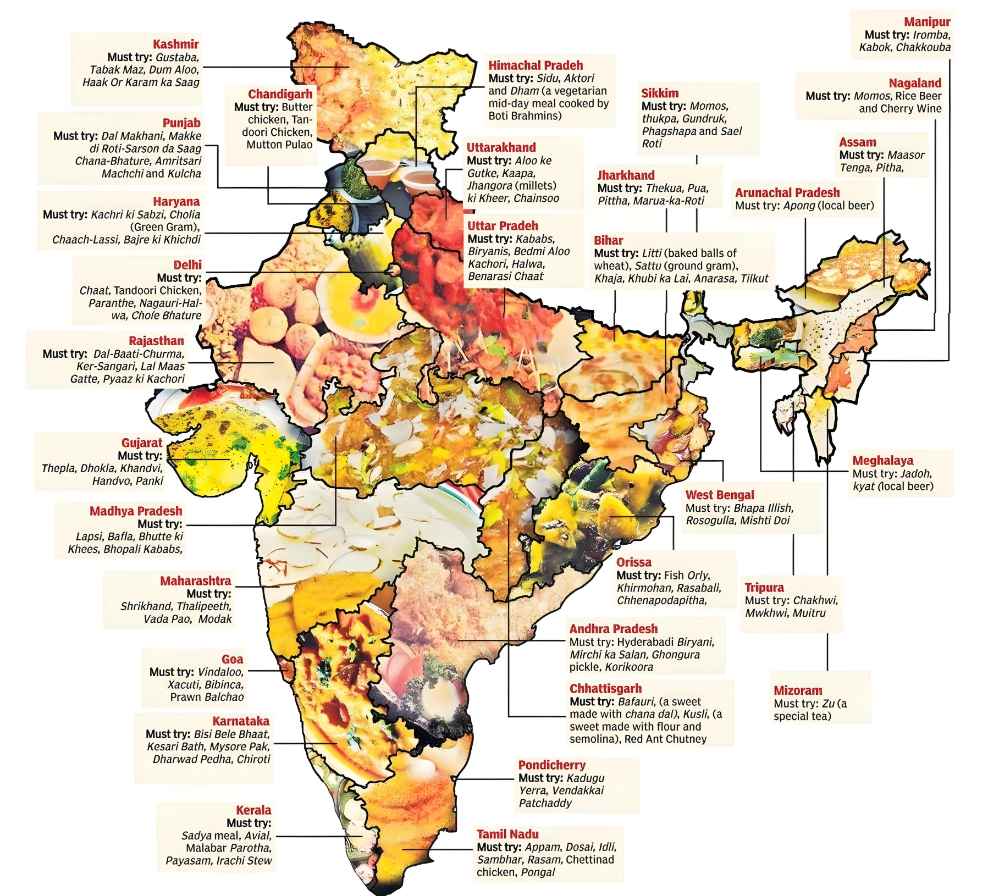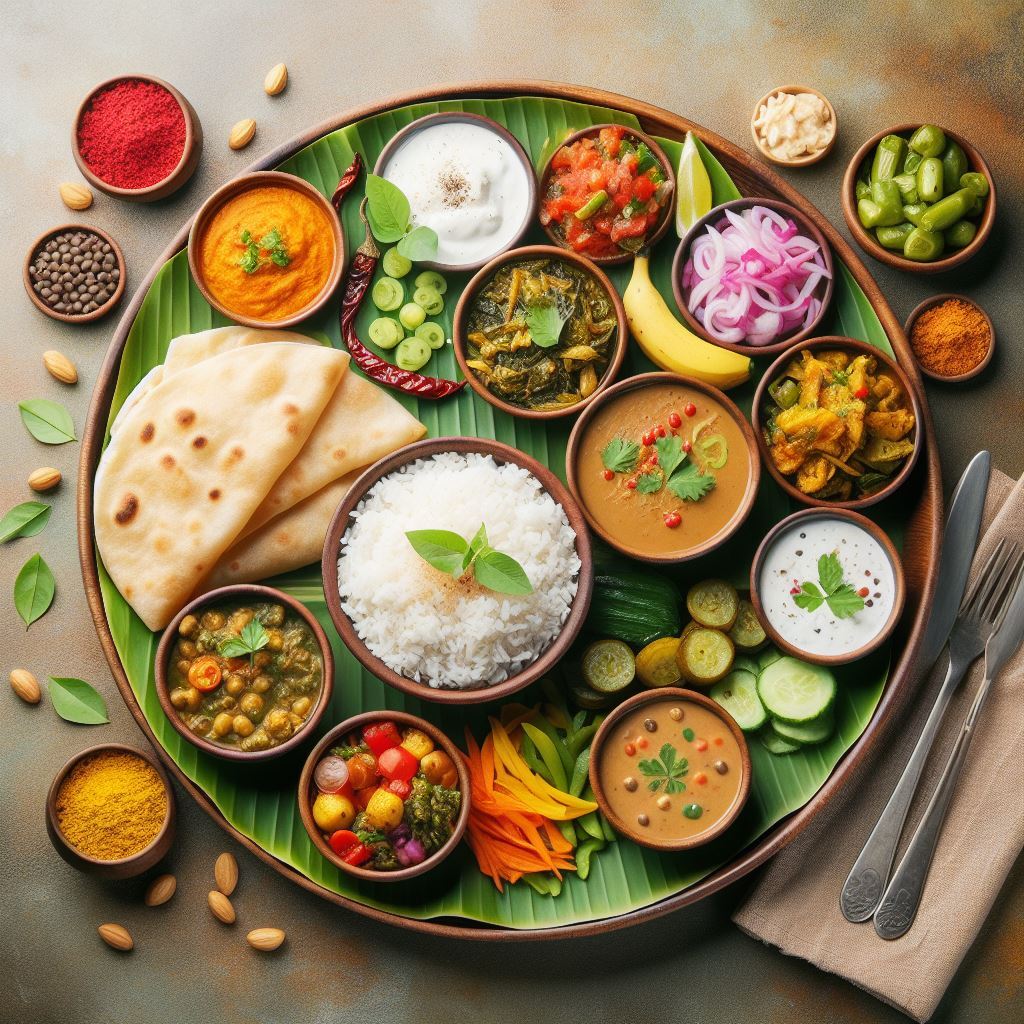- Jan. 25, 2024
- Siddhi Talgaonkar
- On Diversity Debate
Unity in Every Bite: A Culinary Exploration of India's Gut Diversity
In the heart of our old Indian home, filled with colorful flowers and the soothing sounds of nature, Grandma fondly recalled, "Back then, our mornings were like a mix of languages and different traditions. Our meals were a blend of flavors that represented India's diverse culture, keeping us healthy in so many delicious ways."
Grandpa, with a hint of nostalgia, added, "We cherished our differences and found togetherness through traditions like Ayurveda, guiding us to a balanced life."
And that's why the saying "Anekta me ekta" holds so true for all Indians. Our country is like a colorful mix of cuisines, languages, faiths, and more-a beautiful mosaic that makes it wonderfully diverse. Our daily lives are a celebration of these differences, from the spices in our curries to the various languages telling our stories.
But it's not just about what you see on the outside; even our stomachs tell a tale of India's many flavors. The food we enjoy adapts to our different habits, showing the unique variety in our digestive systems. This internal harmony highlights our strength and proves that diversity doesn't break unity; it thrives within it. In every taste, language, and heartbeat, we find the essence of our incredible country.
Gut microbiome profile of Indians:
The "Landscape of Gut Microbiome - Pan-India Exploration" (LogMPIE) project is the first large-scale, national record of the Indian gut microbiome. Determining and mapping the baseline Indian gut microbiota was the main goal of the research. This observational research was carried out in 14 different Indian regions. The participants who enrolled were evenly dispersed in terms of body mass index (obese and non-obese) and geographic regions (north, east, west, and south). In addition, the research design took into account variables like age and physical activity that affect the microbiome. The LogMPIE study collected data from 1004 eligible participants and identified 993 distinct microbes from the Indian microbiome diaspora. The predominant species of microbes found in the Indian gut are Prevotella copri and Faecalibacterium prausnitzii. Other highly abundant microbes in Indians compared with people living elsewhere in the world include Mitsuokella, Lactobacillus, and Megasphaera. The Prevotella were found in the gut of people who consumed plant-based diets. Lactobacillus, Megasphaera, and Mitsuokella were dominant in people whose diets contained fermented foods and dairy products. The information serves as a valuable resource for research, analysis, and identification of signs defining the participants' physiological dispositions, in addition to mapping the baseline gut microbiota of India. Moreover, they shed light on the distinctive characteristics that describe the Indian microbiome.
Region-wise gut microbiome difference
In North India, indulgence in fluffy naan, creamy dal makhani, and spicy tandoori delights creates a gastronomic landscape rich in probiotics and prebiotics. The gut health of North Indians oscillates between climatic problems and spicy strengths. It feeds on foods high in fiber and strong spices to produce good bacteria. Summer heat and water problems, however, are hazards. The gut microbiota of North Indians is shaped by a special combination of dietary diversity and environmental challenges, which makes it an interesting field for future study and supports customs for gut health.
- They primarily consume a plant-based diet, which is associated with Prevotella and shows enrichment of branched-chain amino acid (BCAA) and lipopolysaccharide biosynthesis pathways. A multicenter study involving healthy individuals from urban northern India (Delhi) and adjacent rural regions suggested 50 core operational taxonomy units (OTUs) among which Prevotella, Megasphaera, Faecalibacterium, Lactobacillus, Ruminococcus, and Roseburia were the most dominant.
Venturing southward, the lush embrace of Kerala unfolds a culinary narrative featuring dosa and sambar infused with the tropical essence of coconut. Fermented rice dishes like idli and appam contribute prebiotics, fostering a healthy gut microbiota. However, the melody isn't always perfect. The microbial equilibrium can be upset by water problems in some places, and the urban beat of processed meals jeopardizes the peace. Nonetheless, the South Indian stomach still has a lot going for it in terms of its traditional tastes and abundance of plant-based foods; it just needs to be deeply studied and supported for best health.
-
They mainly consume an omnivorous diet, which shows associations with Bacteroides, Ruminococcus, and Faecalibacterium and has an enrichment of short chain fatty acid (SCFA) biosynthesis pathway and branched-chain amino acid (BCAA) transporters. The concentration of BCAAs was found to be higher in the fecal metabolome of the Southern India cohort and shows a positive correlation with the higher abundance of BCAA transporters. Another study found that the microbiome of participants from Kerala was enriched in species of Bifidobacterium, Ruminococcus, Clostridium, and Faecalibacterium.
The Western tales, from Goa's sun-kissed coasts to Gujarat's arid expanses, showcase a fresh turn in the gut health saga. Fresh fish from Goa and Gujarat offer omega-3 fats and fiber, while besan meals contribute beneficial bacteria and protein. Although very popular, the spicy food of Gujarat may cause upset stomachs, and consuming too much oil might worsen digestive problems. In Maharashtra, the stress and sedentary lifestyles of cities like Mumbai can worsen the effects of urbanization on diets, problems with water quality, and some cultural practices on gut health.
-
The gut microbiome of individuals from the Western region of India, specifically Ahmedabad city, is dominated by a Prevotella microbial community. The typical diet included carbohydrate and fiber-rich components (predominantly whole grains and legume-based preparations), which appear to validate the proposed correlation between diet, geography and microbiome composition.
Journeying eastward, fermented foods and spice-infused music set the beat for East Indian intestinal wellness. The delicious chorus of Dahi restores intestinal flora and strengthens immunity. Turmeric adds anti-inflammatory overtones to fish curries like Machher Jhol, balancing intestinal health. The fiber bassline of Litti Chokha keeps you full and facilitates easy digestion. It might be difficult for East Indian people to keep their gut flora healthy due to the restricted availability of clean water. Moreover, access to foods that are good for the stomach is hampered by socioeconomic gaps, which are characterized by poverty and malnutrition and exacerbate gut health problems in these areas.
Along with the food, the climatic conditions and lifestyle of the people also affect the gut health of people in all these regions.

Img 1- Indian diversity in food
The image above describes some of the most well-known foods from the various Indian states.
https://www.humanium.org/en/indian-food-diversity/
Why are Indians facing more gut issues now than ever?
From birth, the gut microbiome undergoes a complex journey influenced by various factors, with minimal diversity in early life giving way to stability and variety in adulthood.
- Contemporary challenges, including a rising BMI (Body Mass Index) due to processed food consumption influenced by Western fast-food chains and sedentary lifestyles, disrupt the delicate balance of the microbiota. This disruption results in an imbalance of harmful and beneficial bacteria, altering gut flora, leading to dysbiosis, and impacting metabolism, food absorption, and overall digestive health. The prevalence of constipation, bloating, and diarrhea underscores the toll of low-fiber, processed foods on gut functionality.
- The prevalence of gut health issues among Indians is a significant concern, as evidenced by a surge in non-communicable diseases such as diabetes, cancer, cardiovascular diseases, stroke, and hypertension. The roots of these issues delve into lifestyle choices, heredity, and the evolving gut microbiome. It is surprising to note that over 61% (5.87 million) of all deaths in India are due to lifestyle & and non-communicable diseases.
What’s the solution?
Addressing the escalating gut health challenges among Indians necessitates a return to ancient food techniques and the incorporation of daily practices such as increased physical activities, mindfulness, and self-care activities following regular routines. Traditional Indian meals, abundant in prebiotics, serve as nutrition for specific gut bacteria, fostering the growth of beneficial microflora. This, in turn, positively impacts the individual, leading to the production of metabolic products that lower blood cholesterol, regulate stomach pH, stimulate the immune system, and enhance mineral absorption. To understand whether we have enough of the beneficial microbes, getting a gut health test becomes important in checking the microbiome composition. Fortunately, Leucine Rich Bio has South Asia’s first microbiome-based test called Bugspeaks, which identifies the microbiota profiles and predicts susceptibility to over 20 diseases by analyzing the stool samples and giving detailed personalized nutritional recommendations.
In the fast-paced modern era, where time is a luxury, it is crucial to recognize the role of exercise as an environmental component influencing gut microbial composition. Eating a diverse range of foods increases the diversity of the microflora and improves the Bacteroidetes-Firmicutes ratio. It emerges as a potent tool to mitigate weight-related pathologies, gastrointestinal disorders, and the incidence of metabolic and obesity-related diseases. Regular physical activity is a therapeutic measure to maintain microbial balance, correct dysbiosis, and improve overall health.

Img 2- Healthy Indian Thali
Behold the gastronomic masterpiece! This picture encapsulates the epitome of an Indian feast, a symphony for a flourishing gut microbiota. Every morsel tells a tale of nutrient harmony, a culinary orchestra ensuring balance in the body's nutritional saga. It's not just a meal; it's the art of wellness on a plate, where diversity reigns supreme, promising a saga of robust health through the magic of varied, wholesome Indian delicacies.
https://www.bing.com/images/create/indian-diet/1-65b15e6261bf4b33bf52c95d3c5e842b?id=9ZYuBB%2fXZSDeCw%2fVcUlFsQ%3d%3d&view=detailv2&idpp=genimg&noidpclose=1&FORM=SYDBIC
Conclusion
The rich mosaic of India's many civilizations, climates, and culinary traditions greatly adds to the country's uniqueness. Every region has a unique variety of meals that affect the gut microbiota, from the rich and spicy cuisines of the North to the coconut-infused delicacies of the South, and from the seafood joys of the West to the rice-centric pleasures of the East. However, the increasing number of non-communicable illnesses among Indians highlights how urgent it is to address gut health concerns.
The makeup of the gut microbiome is seriously threatened by the trend towards processed meals, reduced physical activity, and the ensuing rise in BMI. An imbalance or dysbiosis can occur, which can cause inflammation, metabolic issues, and digestive difficulties. To overcome these obstacles, Indians must return to their traditional diets, with a focus on foods high in prebiotics and getting their gut tested. Including regular exercise in daily routines can also have a favorable impact on gut bacteria diversity, which in turn promotes general well-being.
So, don’t you think the best way to embrace the uniqueness of India is to incorporate healthy food choices from different regions into our diets because increasing diversity in our plates ensures diversity in our gut and lessens the increasing number of Indians suffering from digestive disorders? Therefore, this Republic Day, let's get back to our traditional nutrition and healthy lifestyle practices and enjoy this rich and diverse India every day!
References
- Shetty, S. A., Marathe, N. P., & Shouche, Y. S. (2013). Opportunities and challenges for gut microbiome studies in the Indian population. Microbiome, 1(1), 1-12.
- Dhakan, D. B., Maji, A., Sharma, A. K., Saxena, R., Pulikkan, J., Grace, T., ... & Sharma, V. K. (2019). The unique composition of Indian gut microbiome, gene catalogue, and associated fecal metabolome deciphered using multi-omics approaches. Gigascience, 8(3), giz004.
- Kedia, S., Rampal, R., Paul, J., & Ahuja, V. (2016). Gut microbiome diversity in acute infective and chronic inflammatory gastrointestinal diseases in North India. Journal of gastroenterology, 51, 660-671.
- Samanta, A. K., Kolte, A. P., Senani, S., Sridhar, M., & Jayapal, N. (2011). Prebiotics in ancient Indian diets. Current Science, 43-46.
- Monda, V., Villano, I., Messina, A., Valenzano, A., Esposito, T., Moscatelli, F., ... & Messina, G. (2017). Exercise modifies the gut microbiota with positive health effects. Oxidative medicine and cellular longevity, 2017.
- Dubey, A. K., Uppadhyaya, N., Nilawe, P., Chauhan, N., Kumar, S., Gupta, U. A., & Bhaduri, A. (2018). LogMPIE, pan-India profiling of the human gut microbiome using 16S rRNA sequencing. Scientific data, 5(1), 1-10.
- https://timesofindia.indiatimes.com/blogs/voices/gut-health-matters-tackling-indias-alarming-rise-in-non-communicable-diseases-from-the-inside-out/
- https://www.hindustantimes.com/fitness/a-guide-to-caring-for-the-indian-gut/story-vdbrFbXP6ZQac5ioDnePnI.html
- https://himalayarestaurant.com.au/the-health-benefits-of-traditional-indian-food/









